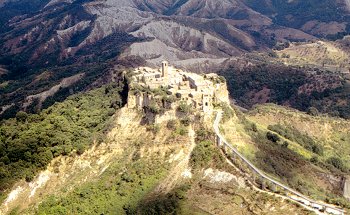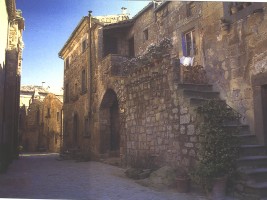Civita di Bagnoregio ranks high as one of the most unusual villages in Italy. This is the place to see when you want to step into history and a strange, almost fantasy landscape less than 100 miles from Rome.
 The Bagnoregio part has the charm of Renaissance architecture, cozy piazzas and a good restaurant, Hostaria del Ponte, with a marvelous view. Civita is quite different. To get to this tiny hilltop settlement above the Tiber River, you walk from Bagnoregio for about a kilometer on a concrete footbridge that crosses an abyss. This is the only way to get to Civita. It’s steep toward the end, with stone steps, but finally you walk through a tunnel and reach Civita’s quiet—very quiet, with no cars—streets.
The Bagnoregio part has the charm of Renaissance architecture, cozy piazzas and a good restaurant, Hostaria del Ponte, with a marvelous view. Civita is quite different. To get to this tiny hilltop settlement above the Tiber River, you walk from Bagnoregio for about a kilometer on a concrete footbridge that crosses an abyss. This is the only way to get to Civita. It’s steep toward the end, with stone steps, but finally you walk through a tunnel and reach Civita’s quiet—very quiet, with no cars—streets.
There are several art studios, ancient buildings, a church on the central piazza, places to sip wine, pots full of flowers, and not much more. Only a few people live here. The reason Civita is so unusual is that it is disappearing. They call it “the dying city” because, gradually, over many centuries, erosion and earthquakes have tugged away at the tufa rock until only this small part remains.
 In Etruscan times, it was a sizable city above fertile valleys and winding streams in what is now the Lazio region. But those streams ate at the plateau and eroded its clay and sand base. In every earthquake, exposed tufa stone and parts of the city tumbled into the valleys. You can see the evidence today, in narrow streets that end abruptly at the edge of the cliff and in walls still standing. The village is riddled with tunnels and caves; some may have been Etruscan tombs. Some are used as wine cellars and cisterns. Everywhere you turn, the views across the collapsed hillsides and wide barren landscape, as far as the Umbrian mountains, are astonishing.
In Etruscan times, it was a sizable city above fertile valleys and winding streams in what is now the Lazio region. But those streams ate at the plateau and eroded its clay and sand base. In every earthquake, exposed tufa stone and parts of the city tumbled into the valleys. You can see the evidence today, in narrow streets that end abruptly at the edge of the cliff and in walls still standing. The village is riddled with tunnels and caves; some may have been Etruscan tombs. Some are used as wine cellars and cisterns. Everywhere you turn, the views across the collapsed hillsides and wide barren landscape, as far as the Umbrian mountains, are astonishing.
Twice a year, the village holds “La Tonna,” a festival that includes donkey races. There’s just one place to stay, a friendly 3-room B&B on the piazza (Piazza del Duomo Vecchio). It’s also a restaurant, Antico Forno, serving excellent local cuisine indoors by the fireplace or outside on the square. Osteria Al Forno di Agnese is a good place for a simple and inexpensive meal.
At Rosanna and Antonio’s Wine Cellar, you’ll be offered delicious panini, bruschetta, and homemade wines. Taste even more bruschetta and wines in Antico Frantoio Bruschetteria, and don’t miss the collection of olive oil presses, one of them some 1500 years old.
You can tour the whole village of Civita in a couple of hours, but spending more time is the way to soak in the atmosphere. It’s a car-free, peaceful, friendly bit of Italy, and it’s different from anywhere else.


Comments